Equity and Trust: Critical Analysis of a Legal Case and Principles
VerifiedAdded on 2020/11/23
|8
|2236
|122
Report
AI Summary
This report provides a comprehensive analysis of equity and trust, exploring their roles within chancery courts and their impact on common law. It begins with an introduction to the core concepts of equity and trust, highlighting their significance in modifying rigid legal applications. The report then delves into a critical evaluation of the case William Grant Morice vs Bishop of Durham, examining the court's role in determining the validity of property transfers and the definition of a trust object. It explores the principles of equity and trust, including the concept of equity as a sense of justice and the characteristics of trust as a collaborative force focused on fulfilling others' needs. The report applies these principles to the case, assessing the transfer of property and the intentions of the parties involved. The report concludes by summarizing the key findings and emphasizing the importance of understanding equity and trust in legal contexts. It also discusses the challenges and difficulties that can arise in equity and trust management, such as lack of understanding and communication, and suggests the need for clear and transparent approaches to overcome these issues.

Equity and Trust
Paraphrase This Document
Need a fresh take? Get an instant paraphrase of this document with our AI Paraphraser
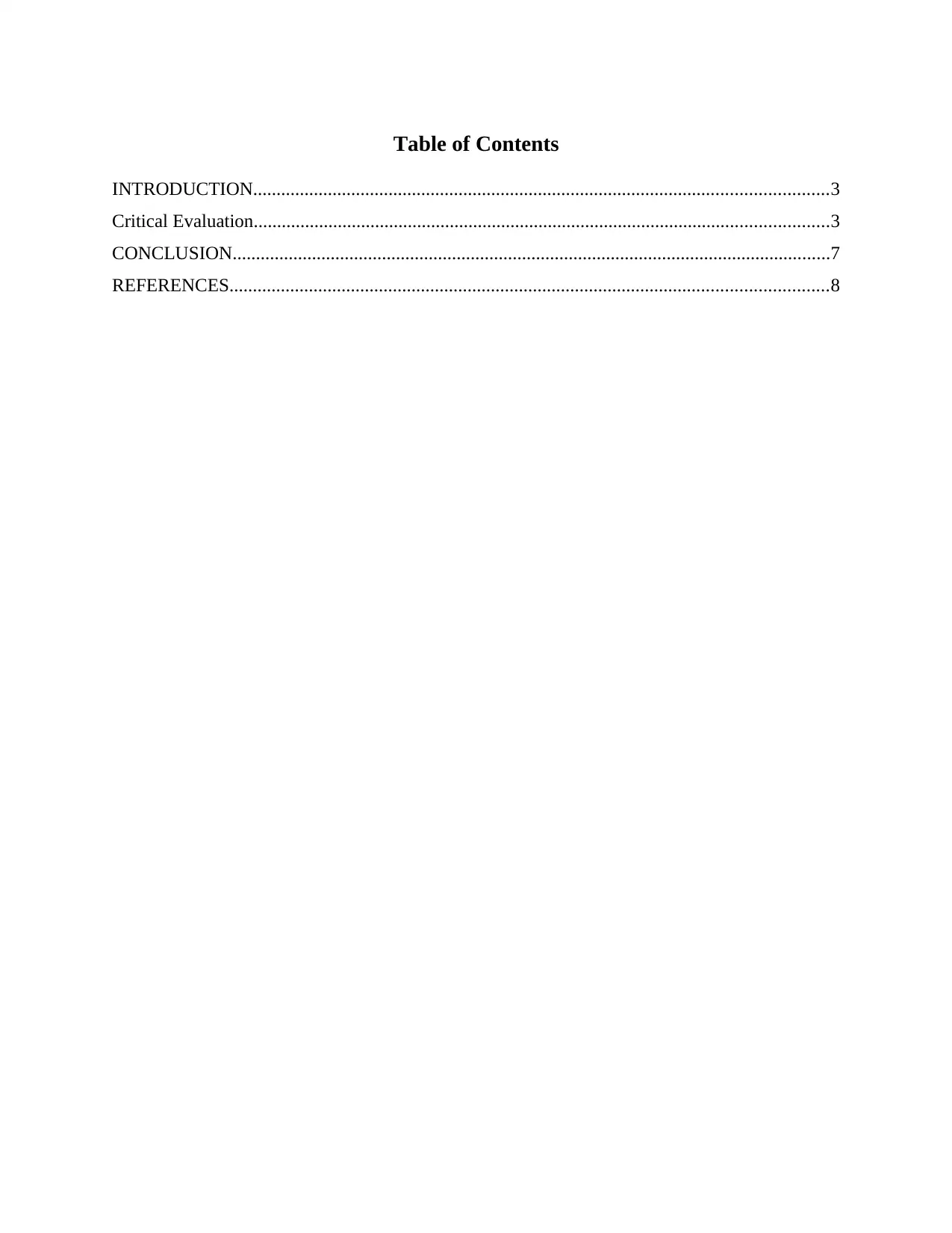
Table of Contents
INTRODUCTION...........................................................................................................................3
Critical Evaluation...........................................................................................................................3
CONCLUSION................................................................................................................................7
REFERENCES................................................................................................................................8
INTRODUCTION...........................................................................................................................3
Critical Evaluation...........................................................................................................................3
CONCLUSION................................................................................................................................7
REFERENCES................................................................................................................................8
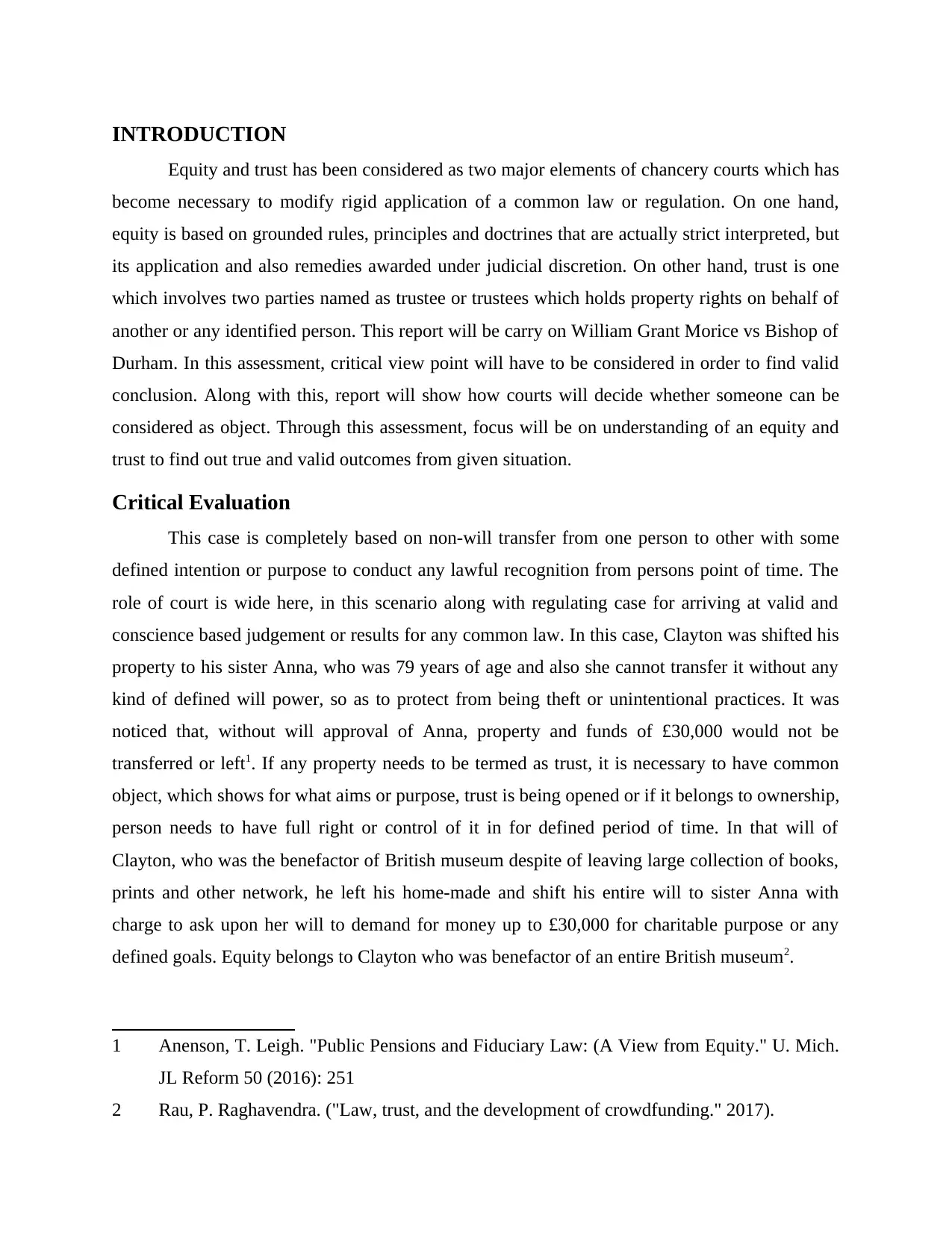
INTRODUCTION
Equity and trust has been considered as two major elements of chancery courts which has
become necessary to modify rigid application of a common law or regulation. On one hand,
equity is based on grounded rules, principles and doctrines that are actually strict interpreted, but
its application and also remedies awarded under judicial discretion. On other hand, trust is one
which involves two parties named as trustee or trustees which holds property rights on behalf of
another or any identified person. This report will be carry on William Grant Morice vs Bishop of
Durham. In this assessment, critical view point will have to be considered in order to find valid
conclusion. Along with this, report will show how courts will decide whether someone can be
considered as object. Through this assessment, focus will be on understanding of an equity and
trust to find out true and valid outcomes from given situation.
Critical Evaluation
This case is completely based on non-will transfer from one person to other with some
defined intention or purpose to conduct any lawful recognition from persons point of time. The
role of court is wide here, in this scenario along with regulating case for arriving at valid and
conscience based judgement or results for any common law. In this case, Clayton was shifted his
property to his sister Anna, who was 79 years of age and also she cannot transfer it without any
kind of defined will power, so as to protect from being theft or unintentional practices. It was
noticed that, without will approval of Anna, property and funds of £30,000 would not be
transferred or left1. If any property needs to be termed as trust, it is necessary to have common
object, which shows for what aims or purpose, trust is being opened or if it belongs to ownership,
person needs to have full right or control of it in for defined period of time. In that will of
Clayton, who was the benefactor of British museum despite of leaving large collection of books,
prints and other network, he left his home-made and shift his entire will to sister Anna with
charge to ask upon her will to demand for money up to £30,000 for charitable purpose or any
defined goals. Equity belongs to Clayton who was benefactor of an entire British museum2.
1 Anenson, T. Leigh. "Public Pensions and Fiduciary Law: (A View from Equity." U. Mich.
JL Reform 50 (2016): 251
2 Rau, P. Raghavendra. ("Law, trust, and the development of crowdfunding." 2017).
Equity and trust has been considered as two major elements of chancery courts which has
become necessary to modify rigid application of a common law or regulation. On one hand,
equity is based on grounded rules, principles and doctrines that are actually strict interpreted, but
its application and also remedies awarded under judicial discretion. On other hand, trust is one
which involves two parties named as trustee or trustees which holds property rights on behalf of
another or any identified person. This report will be carry on William Grant Morice vs Bishop of
Durham. In this assessment, critical view point will have to be considered in order to find valid
conclusion. Along with this, report will show how courts will decide whether someone can be
considered as object. Through this assessment, focus will be on understanding of an equity and
trust to find out true and valid outcomes from given situation.
Critical Evaluation
This case is completely based on non-will transfer from one person to other with some
defined intention or purpose to conduct any lawful recognition from persons point of time. The
role of court is wide here, in this scenario along with regulating case for arriving at valid and
conscience based judgement or results for any common law. In this case, Clayton was shifted his
property to his sister Anna, who was 79 years of age and also she cannot transfer it without any
kind of defined will power, so as to protect from being theft or unintentional practices. It was
noticed that, without will approval of Anna, property and funds of £30,000 would not be
transferred or left1. If any property needs to be termed as trust, it is necessary to have common
object, which shows for what aims or purpose, trust is being opened or if it belongs to ownership,
person needs to have full right or control of it in for defined period of time. In that will of
Clayton, who was the benefactor of British museum despite of leaving large collection of books,
prints and other network, he left his home-made and shift his entire will to sister Anna with
charge to ask upon her will to demand for money up to £30,000 for charitable purpose or any
defined goals. Equity belongs to Clayton who was benefactor of an entire British museum2.
1 Anenson, T. Leigh. "Public Pensions and Fiduciary Law: (A View from Equity." U. Mich.
JL Reform 50 (2016): 251
2 Rau, P. Raghavendra. ("Law, trust, and the development of crowdfunding." 2017).
⊘ This is a preview!⊘
Do you want full access?
Subscribe today to unlock all pages.

Trusted by 1+ million students worldwide

Equity and trusts are two different concept, on one hand, equity is a situation, when one
person is described about its ownership or show his responsibility for holding any personal
property for one common purpose or desired goal to accumulate more and more money, one
other hand, trust generally prepared with purpose to do welfare activities such as Temple, church
to help others3. Ineffective regulation of work is prohibited in case of bringing trust into the
consideration along with protecting it for longer period of time.
Principles and rules of Equity and trust
Equity has been refers to as tangible sense of justice rather than anything tangible or any
physical. Apart from this, it has both legal and ethical consideration. It generally involves what is
equitable which has come to represent behavioural neutrality, this in turn is equated with fair and
just conduct. There are various principles of equity are as follows:
Equity as a body of law: This application of justice has gradually resulted in an evolution
of tangible and equitable rules and principles which is initiated by common law and also a
primary source of difference between common law and equity today which lies in the method of
implementation.
Equity corrects the law: Equity acts as corrective to defined laws or regulation, if the law
operates , so harshly that it actually undermines itself. It is imperative, that every rational system
of jurisprudence has a place for equity in every legal system or measures of proposed system.
Equity follows substance over form: It appeals natural law principles which are
discoverable by human reason. Consideration is given to an underlying intent of the law rather
that it strict form4.
Here are some, principles of trust:
Focus on the other: Trust is meant to helps other or focus on helping others or fulfilling
their needs and wants. It is kind of centric force to look on others along with its forces on
fulfilling other desires or wants over the period of time.
3 Strong, Stacie I. "Arbitration of Trust Disputes: Two Bodies of Law Collide. ("Vand. J.
Transnat'l L. 45 2012): 1157.
4 McLean, Gary, et al. "General practice funding underpins the persistence of the inverse
care law: cross-sectional study in Scotland." Br J Gen Pract 65.641 (2015): e799-e805.
person is described about its ownership or show his responsibility for holding any personal
property for one common purpose or desired goal to accumulate more and more money, one
other hand, trust generally prepared with purpose to do welfare activities such as Temple, church
to help others3. Ineffective regulation of work is prohibited in case of bringing trust into the
consideration along with protecting it for longer period of time.
Principles and rules of Equity and trust
Equity has been refers to as tangible sense of justice rather than anything tangible or any
physical. Apart from this, it has both legal and ethical consideration. It generally involves what is
equitable which has come to represent behavioural neutrality, this in turn is equated with fair and
just conduct. There are various principles of equity are as follows:
Equity as a body of law: This application of justice has gradually resulted in an evolution
of tangible and equitable rules and principles which is initiated by common law and also a
primary source of difference between common law and equity today which lies in the method of
implementation.
Equity corrects the law: Equity acts as corrective to defined laws or regulation, if the law
operates , so harshly that it actually undermines itself. It is imperative, that every rational system
of jurisprudence has a place for equity in every legal system or measures of proposed system.
Equity follows substance over form: It appeals natural law principles which are
discoverable by human reason. Consideration is given to an underlying intent of the law rather
that it strict form4.
Here are some, principles of trust:
Focus on the other: Trust is meant to helps other or focus on helping others or fulfilling
their needs and wants. It is kind of centric force to look on others along with its forces on
fulfilling other desires or wants over the period of time.
3 Strong, Stacie I. "Arbitration of Trust Disputes: Two Bodies of Law Collide. ("Vand. J.
Transnat'l L. 45 2012): 1157.
4 McLean, Gary, et al. "General practice funding underpins the persistence of the inverse
care law: cross-sectional study in Scotland." Br J Gen Pract 65.641 (2015): e799-e805.
Paraphrase This Document
Need a fresh take? Get an instant paraphrase of this document with our AI Paraphraser

Collaborative force: Trust is a kind of collaborative relationship with others. True kind
of collaboration is very fundamental and default inclination to work together, creating both joint
goals and joint approaches to getting there.
Medium to long term relationship: It basically focusing relationships nurtures and also
ultimately generates more transaction. Trust never establishes with an effort to generate higher
and higher profits but also an initiative to form social status and relationship for common welfare
or tasks5.
Rules of equity and trust: There has to be positive intention, irrespective what is the
major nature of entity and also it should perform its task with full majority and with an intention
to social cause or justification. It was noticed that rules of equity and trust needs to have full and
clear judgement for longer and precious scope of work. Trust needs to have right to report any
critical circumstances or issue, might be other person is undertaking with its right and suitable
for longer duration. Trust rules needs to be structured in accordance with its activities which
carry with what purpose.
Application of rules on given situation:
In this case, Clayton shifts its entire trust to his sister Anna with power to control its
major functioning to transfer nay formal money with major approval of the Ana. The property
which was transferred to Ana was trust based property and association to protect it from being
copied or dis-regulated. After death of Ann, her cousin Anne vs William has sued to overturn the
bill. In response to this, William already been bequeathed £16,000. Here, involvement of rules of
trust is necessary to be undertaken along with discretion of the trustee shall most approve of it.
As, Clayton transferred its will to Ann to maintain long term relationship, but it won't
happen. After the death of Ann, entire will was transferred to William with the control of ethical
and critical measures to overcome it in definite period of time. Rules of equity is suitably
applicable here, if a person is holding any property, it cannot be comes under category of trust or
cannot termed as trust, in any documentary6. Here, in this document, role of fairness is required
to rightly disclosed it with right intention or purpose to hold it for right or purposeful measures.
5 Chang, Yun-chien, and Henry E. Smith. "An economic analysis of civil versus common
law property." Notre Dame L. Rev. 88 (2012): 1.
6 Werbach, Kevin. "Trust, but verify: Why the blockchain needs the law." Berkeley Tech.
LJ 33 (2018): 487.
of collaboration is very fundamental and default inclination to work together, creating both joint
goals and joint approaches to getting there.
Medium to long term relationship: It basically focusing relationships nurtures and also
ultimately generates more transaction. Trust never establishes with an effort to generate higher
and higher profits but also an initiative to form social status and relationship for common welfare
or tasks5.
Rules of equity and trust: There has to be positive intention, irrespective what is the
major nature of entity and also it should perform its task with full majority and with an intention
to social cause or justification. It was noticed that rules of equity and trust needs to have full and
clear judgement for longer and precious scope of work. Trust needs to have right to report any
critical circumstances or issue, might be other person is undertaking with its right and suitable
for longer duration. Trust rules needs to be structured in accordance with its activities which
carry with what purpose.
Application of rules on given situation:
In this case, Clayton shifts its entire trust to his sister Anna with power to control its
major functioning to transfer nay formal money with major approval of the Ana. The property
which was transferred to Ana was trust based property and association to protect it from being
copied or dis-regulated. After death of Ann, her cousin Anne vs William has sued to overturn the
bill. In response to this, William already been bequeathed £16,000. Here, involvement of rules of
trust is necessary to be undertaken along with discretion of the trustee shall most approve of it.
As, Clayton transferred its will to Ann to maintain long term relationship, but it won't
happen. After the death of Ann, entire will was transferred to William with the control of ethical
and critical measures to overcome it in definite period of time. Rules of equity is suitably
applicable here, if a person is holding any property, it cannot be comes under category of trust or
cannot termed as trust, in any documentary6. Here, in this document, role of fairness is required
to rightly disclosed it with right intention or purpose to hold it for right or purposeful measures.
5 Chang, Yun-chien, and Henry E. Smith. "An economic analysis of civil versus common
law property." Notre Dame L. Rev. 88 (2012): 1.
6 Werbach, Kevin. "Trust, but verify: Why the blockchain needs the law." Berkeley Tech.
LJ 33 (2018): 487.
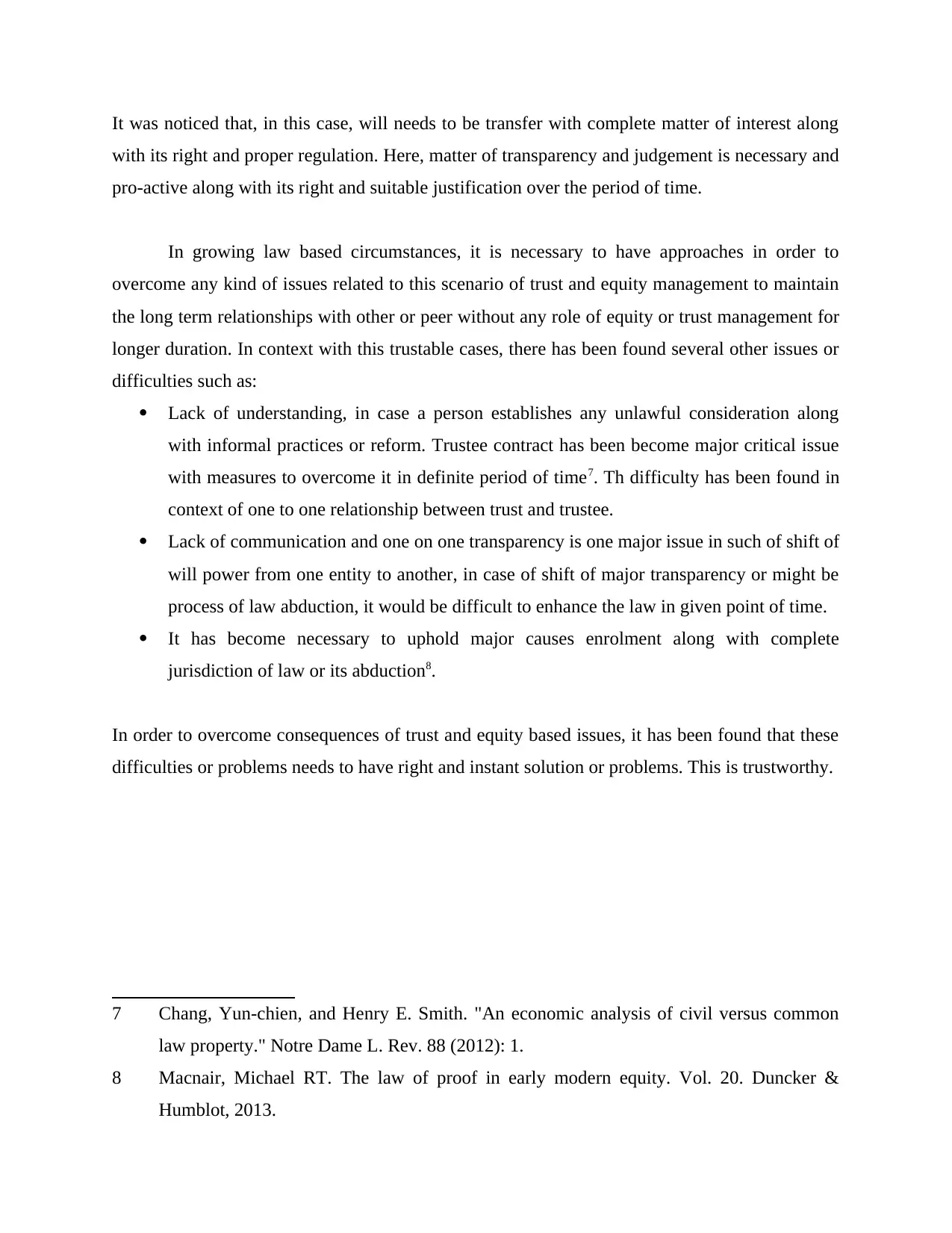
It was noticed that, in this case, will needs to be transfer with complete matter of interest along
with its right and proper regulation. Here, matter of transparency and judgement is necessary and
pro-active along with its right and suitable justification over the period of time.
In growing law based circumstances, it is necessary to have approaches in order to
overcome any kind of issues related to this scenario of trust and equity management to maintain
the long term relationships with other or peer without any role of equity or trust management for
longer duration. In context with this trustable cases, there has been found several other issues or
difficulties such as:
Lack of understanding, in case a person establishes any unlawful consideration along
with informal practices or reform. Trustee contract has been become major critical issue
with measures to overcome it in definite period of time7. Th difficulty has been found in
context of one to one relationship between trust and trustee.
Lack of communication and one on one transparency is one major issue in such of shift of
will power from one entity to another, in case of shift of major transparency or might be
process of law abduction, it would be difficult to enhance the law in given point of time.
It has become necessary to uphold major causes enrolment along with complete
jurisdiction of law or its abduction8.
In order to overcome consequences of trust and equity based issues, it has been found that these
difficulties or problems needs to have right and instant solution or problems. This is trustworthy.
7 Chang, Yun-chien, and Henry E. Smith. "An economic analysis of civil versus common
law property." Notre Dame L. Rev. 88 (2012): 1.
8 Macnair, Michael RT. The law of proof in early modern equity. Vol. 20. Duncker &
Humblot, 2013.
with its right and proper regulation. Here, matter of transparency and judgement is necessary and
pro-active along with its right and suitable justification over the period of time.
In growing law based circumstances, it is necessary to have approaches in order to
overcome any kind of issues related to this scenario of trust and equity management to maintain
the long term relationships with other or peer without any role of equity or trust management for
longer duration. In context with this trustable cases, there has been found several other issues or
difficulties such as:
Lack of understanding, in case a person establishes any unlawful consideration along
with informal practices or reform. Trustee contract has been become major critical issue
with measures to overcome it in definite period of time7. Th difficulty has been found in
context of one to one relationship between trust and trustee.
Lack of communication and one on one transparency is one major issue in such of shift of
will power from one entity to another, in case of shift of major transparency or might be
process of law abduction, it would be difficult to enhance the law in given point of time.
It has become necessary to uphold major causes enrolment along with complete
jurisdiction of law or its abduction8.
In order to overcome consequences of trust and equity based issues, it has been found that these
difficulties or problems needs to have right and instant solution or problems. This is trustworthy.
7 Chang, Yun-chien, and Henry E. Smith. "An economic analysis of civil versus common
law property." Notre Dame L. Rev. 88 (2012): 1.
8 Macnair, Michael RT. The law of proof in early modern equity. Vol. 20. Duncker &
Humblot, 2013.
⊘ This is a preview!⊘
Do you want full access?
Subscribe today to unlock all pages.

Trusted by 1+ million students worldwide
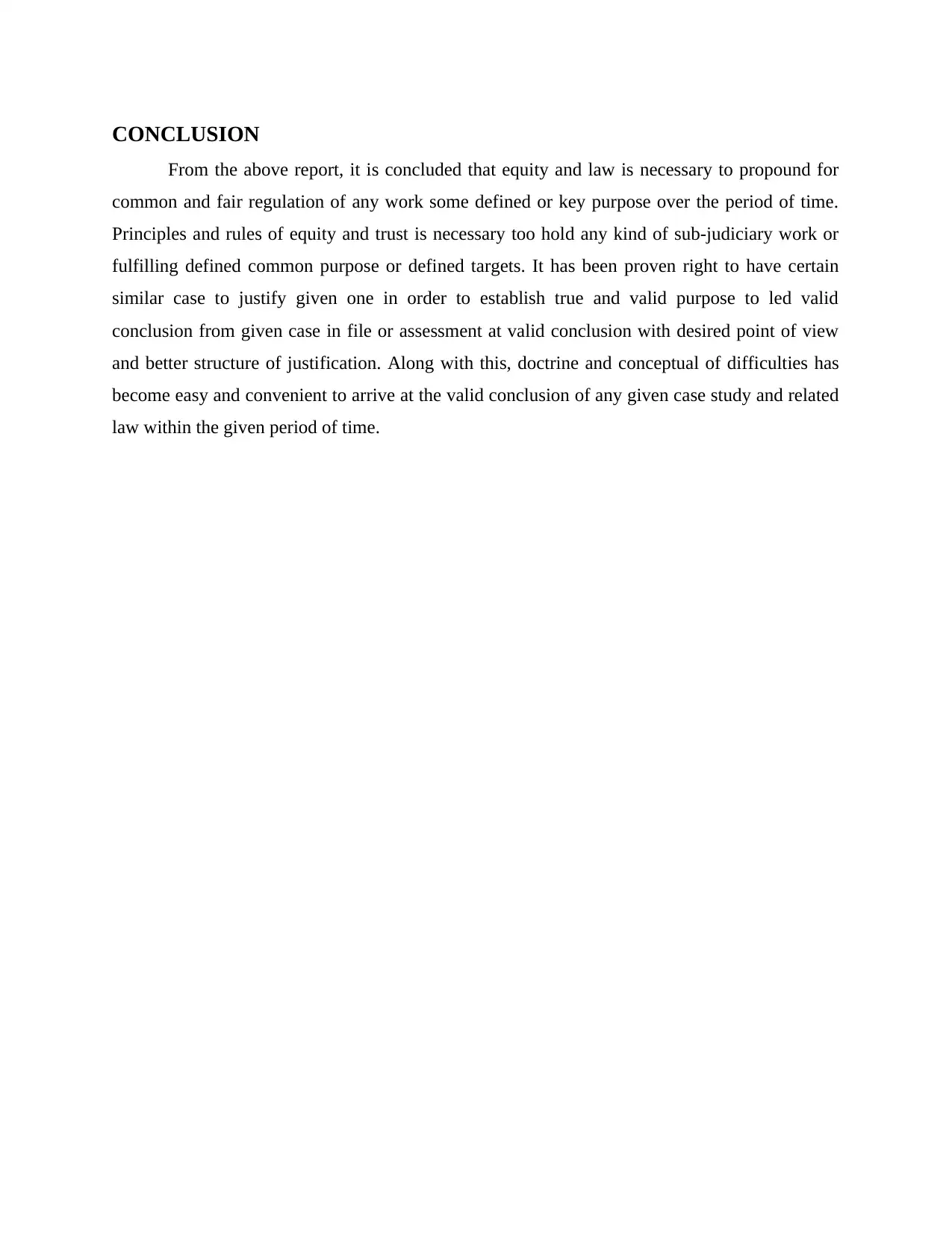
CONCLUSION
From the above report, it is concluded that equity and law is necessary to propound for
common and fair regulation of any work some defined or key purpose over the period of time.
Principles and rules of equity and trust is necessary too hold any kind of sub-judiciary work or
fulfilling defined common purpose or defined targets. It has been proven right to have certain
similar case to justify given one in order to establish true and valid purpose to led valid
conclusion from given case in file or assessment at valid conclusion with desired point of view
and better structure of justification. Along with this, doctrine and conceptual of difficulties has
become easy and convenient to arrive at the valid conclusion of any given case study and related
law within the given period of time.
From the above report, it is concluded that equity and law is necessary to propound for
common and fair regulation of any work some defined or key purpose over the period of time.
Principles and rules of equity and trust is necessary too hold any kind of sub-judiciary work or
fulfilling defined common purpose or defined targets. It has been proven right to have certain
similar case to justify given one in order to establish true and valid purpose to led valid
conclusion from given case in file or assessment at valid conclusion with desired point of view
and better structure of justification. Along with this, doctrine and conceptual of difficulties has
become easy and convenient to arrive at the valid conclusion of any given case study and related
law within the given period of time.
Paraphrase This Document
Need a fresh take? Get an instant paraphrase of this document with our AI Paraphraser
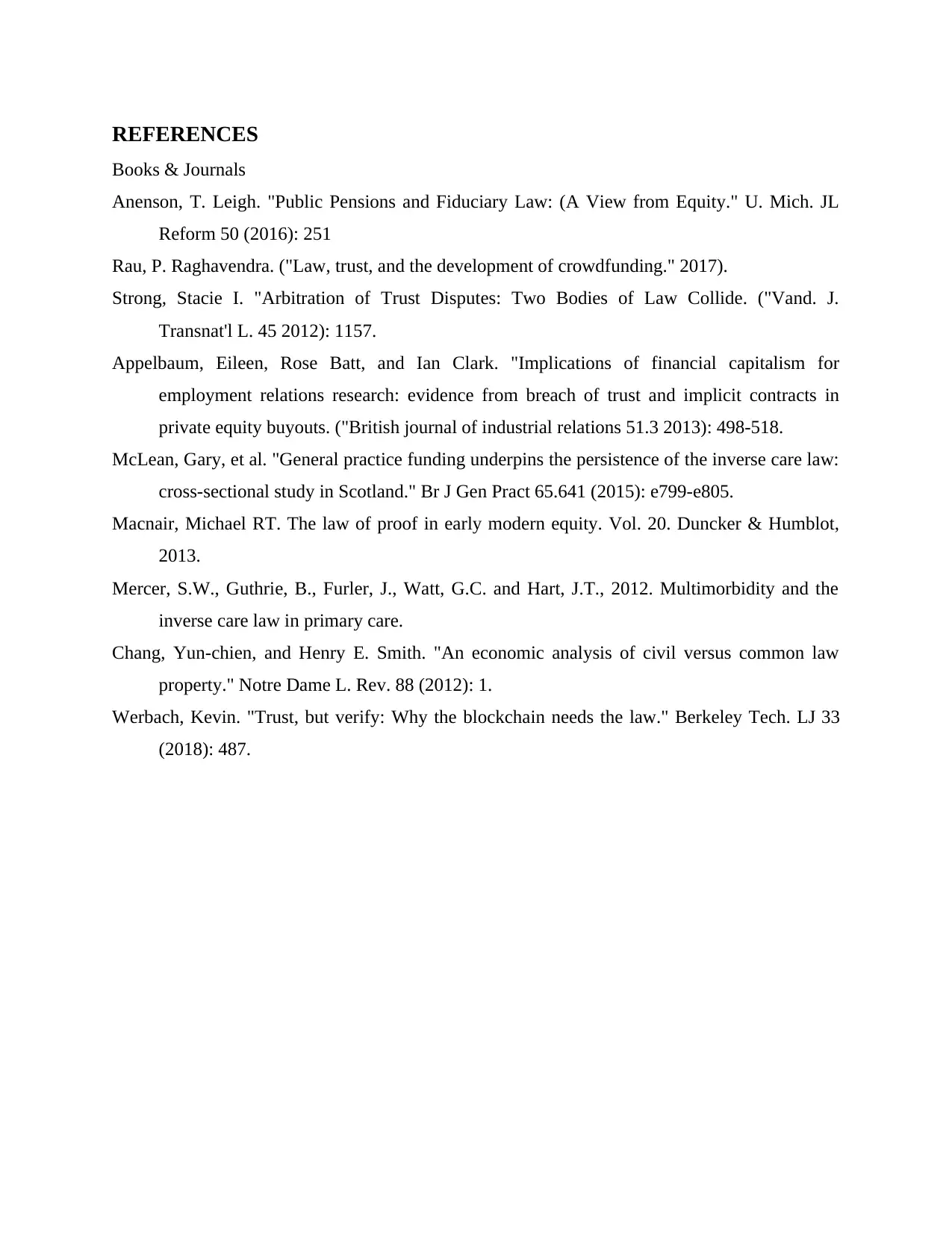
REFERENCES
Books & Journals
Anenson, T. Leigh. "Public Pensions and Fiduciary Law: (A View from Equity." U. Mich. JL
Reform 50 (2016): 251
Rau, P. Raghavendra. ("Law, trust, and the development of crowdfunding." 2017).
Strong, Stacie I. "Arbitration of Trust Disputes: Two Bodies of Law Collide. ("Vand. J.
Transnat'l L. 45 2012): 1157.
Appelbaum, Eileen, Rose Batt, and Ian Clark. "Implications of financial capitalism for
employment relations research: evidence from breach of trust and implicit contracts in
private equity buyouts. ("British journal of industrial relations 51.3 2013): 498-518.
McLean, Gary, et al. "General practice funding underpins the persistence of the inverse care law:
cross-sectional study in Scotland." Br J Gen Pract 65.641 (2015): e799-e805.
Macnair, Michael RT. The law of proof in early modern equity. Vol. 20. Duncker & Humblot,
2013.
Mercer, S.W., Guthrie, B., Furler, J., Watt, G.C. and Hart, J.T., 2012. Multimorbidity and the
inverse care law in primary care.
Chang, Yun-chien, and Henry E. Smith. "An economic analysis of civil versus common law
property." Notre Dame L. Rev. 88 (2012): 1.
Werbach, Kevin. "Trust, but verify: Why the blockchain needs the law." Berkeley Tech. LJ 33
(2018): 487.
Books & Journals
Anenson, T. Leigh. "Public Pensions and Fiduciary Law: (A View from Equity." U. Mich. JL
Reform 50 (2016): 251
Rau, P. Raghavendra. ("Law, trust, and the development of crowdfunding." 2017).
Strong, Stacie I. "Arbitration of Trust Disputes: Two Bodies of Law Collide. ("Vand. J.
Transnat'l L. 45 2012): 1157.
Appelbaum, Eileen, Rose Batt, and Ian Clark. "Implications of financial capitalism for
employment relations research: evidence from breach of trust and implicit contracts in
private equity buyouts. ("British journal of industrial relations 51.3 2013): 498-518.
McLean, Gary, et al. "General practice funding underpins the persistence of the inverse care law:
cross-sectional study in Scotland." Br J Gen Pract 65.641 (2015): e799-e805.
Macnair, Michael RT. The law of proof in early modern equity. Vol. 20. Duncker & Humblot,
2013.
Mercer, S.W., Guthrie, B., Furler, J., Watt, G.C. and Hart, J.T., 2012. Multimorbidity and the
inverse care law in primary care.
Chang, Yun-chien, and Henry E. Smith. "An economic analysis of civil versus common law
property." Notre Dame L. Rev. 88 (2012): 1.
Werbach, Kevin. "Trust, but verify: Why the blockchain needs the law." Berkeley Tech. LJ 33
(2018): 487.
1 out of 8
Related Documents
Your All-in-One AI-Powered Toolkit for Academic Success.
+13062052269
info@desklib.com
Available 24*7 on WhatsApp / Email
![[object Object]](/_next/static/media/star-bottom.7253800d.svg)
Unlock your academic potential
Copyright © 2020–2025 A2Z Services. All Rights Reserved. Developed and managed by ZUCOL.





